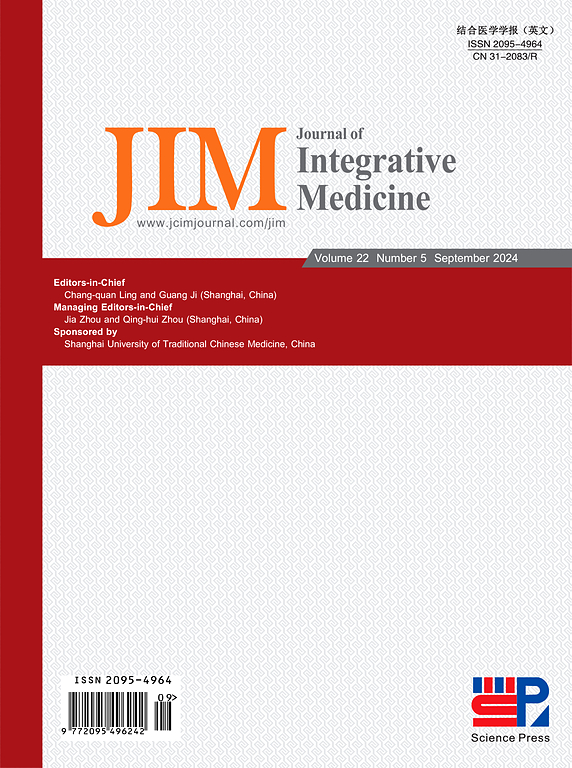辅助性非药物措施对改善严重 COVID-19 患者呼吸道症状的有效性和安全性:多中心随机对照试验。
IF 4
2区 医学
Q1 INTEGRATIVE & COMPLEMENTARY MEDICINE
引用次数: 0
摘要
背景:2022 年末,冠状病毒病 2019(COVID-19)感染的爆发给公共医疗保健带来了巨大的威胁和负担。针灸、拔罐、艾灸等中医非药物疗法是我国常用的辅助治疗手段,但其效果尚不明确:观察中医非药物疗法在改善重症 COVID-19 患者呼吸功能和症状方面的临床效果:本研究为多中心、评估者盲法、随机对照试验。COVID-19住院患者被随机分配到治疗组或对照组。治疗组接受个体化的中医非药物措施并结合俯卧位通气,而对照组仅接受连续 5 天的俯卧位通气:主要结果指标:5 天干预结束时,血氧饱和度(SpO2)得到改善的患者比例,以及患者呼吸频率的变化。次要结果指标包括 SpO2 的变化和自制呼吸症状量表的总分。此外,还记录了SpO2连续3天上升的改善率、俯卧位持续时间和不良事件:在纳入意向治疗分析的 198 名患者中,159 人(80.3%)在第 5 天完成了所有评估,39 人(19.7%)退出了研究。干预结束时,治疗组有 71 名(91%)患者的 SpO2 超过了 93%,而对照组有 61 名(75.3%)达到了这一水平。干预组中 SpO2 有所改善的患者比例明显更高(平均差 [MD] = 15.7;95% 置信区间 [CI]:4.4, 27.1;95% 置信区间 [CI]:4.4, 27.1):4.4, 27.1; P = 0.008).与基线相比,两组患者在接受日常治疗后,呼吸频率均有显著下降,但组间无统计学差异(P 均≥ 0.05)。与对照组相比,治疗组患者的呼吸相关症状评分在治疗第 3 天后降低(MD = -1.7; 95%CI: -2.8, -0.5;P=0.008)。两组患者的总分也逐渐下降。干预期间发生了31起不良事件,2名患者因病情恶化转入重症监护室:结论:中医非药物疗法结合俯卧位能有效治疗重症 COVID-19 患者。结论:中医非药物疗法联合俯卧位能有效治疗重症 COVID-19 患者,与单纯俯卧位相比,联合疗法能明显提高 SpO2,改善症状评分,从而改善患者的呼吸功能,帮助患者康复。然而,两组患者的改善率并无差异:试验注册:中国临床试验注册中心(ChiCTR2300068319)。本文引用如前:Yin X, Jin Z, Li F, Huang L, Hu YM, Zhu BC, Wang ZQ, Li XY, Li JP, Lao LX, Mi YQ, Xu SF.非药物辅助措施改善重症 COVID-19 患者呼吸道症状的有效性和安全性:多中心随机对照试验J Integr Med.2024; Epub ahead of print.本文章由计算机程序翻译,如有差异,请以英文原文为准。
Effectiveness and safety of adjunctive non-drug measures in improving respiratory symptoms among patients with severe COVID-19: A multicenter randomized controlled trial
Background
The outbreak of coronavirus disease 2019 (COVID-19) infection posed a huge threat and burden to public healthcare in late 2022. Non-drug measures of traditional Chinese medicine (TCM), such as acupuncture, cupping and moxibustion, are commonly used as adjuncts in China to help in severe cases, but their effects remain unclear.
Objectives
To observe the clinical effect of TCM non-drug measures in improving respiratory function and symptoms among patients with severe COVID-19.
Design, setting, participants and interventions
This study was designed as a multicenter, assessor-blind, randomized controlled trial. Hospitalized patients with COVID-19 were randomly assigned to the treatment or control group. The treatment group received individualized TCM non-drug measures in combination with prone position ventilation, while the control group received prone position ventilation only for 5 consecutive days.
Main outcome measures
The primary outcome measures were the percentage of patients with improved oxygen saturation (SpO2) at the end of the 5-day intervention, as well as changes of patients’ respiratory rates. The secondary outcome measures included changes in SpO2 and total score on the self-made respiratory symptom scale. The improvement rate, defined as a 3-day consecutive increase in SpO2, the duration of prone positioning, and adverse events were recorded as well.
Results
Among the 198 patients included in the intention-to-treat analysis, 159 (80.3%) completed all assessments on day 5, and 39 (19.7%) patients withdrew from the study. At the end of the intervention, 71 (91%) patients in the treatment group had SpO2 above 93%, while 61 (75.3%) in the control group reached this level. The proportion of participant with improved SpO2 was significantly greater in the intervention group (mean difference [MD] = 15.7; 95% confidence interval [CI]: 4.4, 27.1; P = 0.008). Compared to the baseline, with daily treatment there were significant daily decreases in respiratory rates in both groups, but no statistical differences between groups were found (all P ≥ 0.05). Compared to the control group, the respiratory-related symptoms score was lower among patients in the treatment group (MD = −1.7; 95% CI: −2.8, −0.5; P = 0.008) after day 3 of treatment. A gradual decrease in the total scores of both groups was also observed. Thirty-one adverse events occurred during the intervention, and 2 patients were transferred to the intensive care unit due to deterioration of their illness.
Conclusion
TCM non-drug measures combined with prone positioning can effectively treat patients with severe COVID-19. The combined therapy significantly increased SpO2 and improved symptom scores compared to prone positioning alone, thus improving the patients’ respiratory function to help them recover. However, the improvement rate did not differ between the two groups.
Trial registration: Chinese Clinical Trial Registry (ChiCTR2300068319).
Please cite this article as: Yin X, Jin Z, Li F, Huang L, Hu YM, Zhu BC, Wang ZQ, Li XY, Li JP, Lao LX, Mi YQ, Xu SF. Effectiveness and safety of adjunctive non-drug measures in improving respiratory symptoms among patients with severe COVID-19: A multicenter randomized controlled trial. J Integr Med. 2024; 22(6): 637–644.
求助全文
通过发布文献求助,成功后即可免费获取论文全文。
去求助
来源期刊

Journal of Integrative Medicine-Jim
Medicine-Complementary and Alternative Medicine
CiteScore
9.20
自引率
4.20%
发文量
3319
期刊介绍:
The predecessor of JIM is the Journal of Chinese Integrative Medicine (Zhong Xi Yi Jie He Xue Bao). With this new, English-language publication, we are committed to make JIM an international platform for publishing high-quality papers on complementary and alternative medicine (CAM) and an open forum in which the different professions and international scholarly communities can exchange views, share research and their clinical experience, discuss CAM education, and confer about issues and problems in our various disciplines and in CAM as a whole in order to promote integrative medicine.
JIM is indexed/abstracted in: MEDLINE/PubMed, ScienceDirect, Emerging Sources Citation Index (ESCI), Scopus, Embase, Chemical Abstracts (CA), CAB Abstracts, EBSCO, WPRIM, JST China, Chinese Science Citation Database (CSCD), and China National Knowledge Infrastructure (CNKI).
JIM Editorial Office uses ThomsonReuters ScholarOne Manuscripts as submitting and review system (submission link: http://mc03.manuscriptcentral.com/jcim-en).
JIM is published bimonthly. Manuscripts submitted to JIM should be written in English. Article types include but are not limited to randomized controlled and pragmatic trials, translational and patient-centered effectiveness outcome studies, case series and reports, clinical trial protocols, preclinical and basic science studies, systematic reviews and meta-analyses, papers on methodology and CAM history or education, conference proceedings, editorials, commentaries, short communications, book reviews, and letters to the editor.
Our purpose is to publish a prestigious international journal for studies in integrative medicine. To achieve this aim, we seek to publish high-quality papers on any aspects of integrative medicine, such as acupuncture and traditional Chinese medicine, Ayurveda medicine, herbal medicine, homeopathy, nutrition, chiropractic, mind-body medicine, taichi, qigong, meditation, and any other modalities of CAM; our commitment to international scope ensures that research and progress from all regions of the world are widely covered. These ensure that articles published in JIM have the maximum exposure to the international scholarly community.
JIM can help its authors let their papers reach the widest possible range of readers, and let all those who share an interest in their research field be concerned with their study.
 求助内容:
求助内容: 应助结果提醒方式:
应助结果提醒方式:


